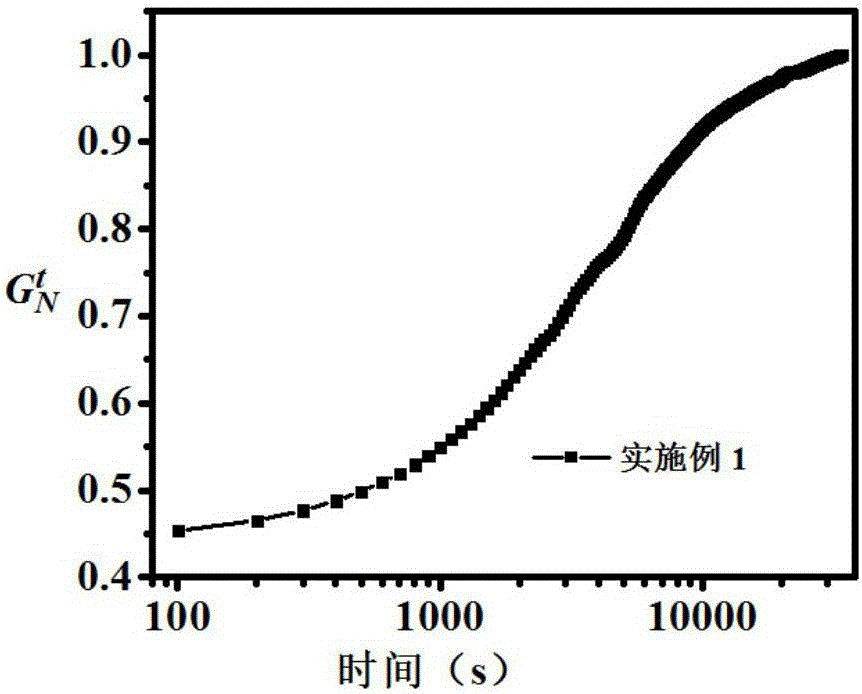Preparation method of Ziegler-Natta catalyst for efficiently preparing low entanglement polyethylene and application
A low-entanglement, polyethylene technology is applied in the field of olefin polymerization catalysts to achieve the effects of eliminating bimetal deactivation, inhibiting the formation of polyethylene chain overlap, and improving polymerization activity.
- Summary
- Abstract
- Description
- Claims
- Application Information
AI Technical Summary
Problems solved by technology
Method used
Image
Examples
Embodiment 1
[0033] (1). 1.0g porous carrier SiO with a pore diameter of 20nm 2 After mixing with 6mmol of 1,4-butanediol in 20mL of tetrahydrofuran (THF) solution for 4h, the alcohol-modified porous support was obtained, and the alcohol-modified porous support was washed with 20mL of THF for 5 times to obtain 1,4-butanediol A porous carrier for alcohol adsorption; (2). The organic substituents of polyhedral oligomeric silsesquioxane (POSS) molecules are replaced with methyl and hydroxyl groups, wherein one POSS molecule contains two hydroxyl groups to obtain a modified The polyhedral oligomeric silsesquioxane molecule of the POSS molecular diameter is 1nm; (3). The modified polyhedral oligomeric silsesquioxane molecule in step (2) is mixed with 6mmolMgCl 2 (The molar ratio of 1,4-butanediol to magnesium atoms is 1) according to the molar ratio of hydroxyl moles in POSS to Mg atoms is 4%, mixed in 20mLTHF to prepare polyhedral oligomeric silsesquioxane molecules / Mg Mixture; (4). The polyh...
Embodiment 2
[0036] (1). After mixing 1.0g of porous carrier alumina with a pore diameter of 100nm and 6mmol of 1-butanol in 20mL of tetrahydrofuran (THF) solution for 4h, an alcohol-modified porous carrier was obtained, which was washed with 20mL of THF to obtain an alcohol-modified Porous carrier 1 time to obtain a porous carrier adsorbed by 1-butanol; (2). The organic substituents of polyhedral oligomerization silsesquioxane (POSS) molecules are replaced with tert-butyl and hydroxyl groups, wherein one POSS molecule Containing 3 hydroxyl groups on the surface, obtain modified polyhedral oligomerization silsesquioxane molecule, POSS molecular diameter is 10nm; (3). The polyhedral oligomerization silsesquioxane modified in step (2) Molecule and 0.6mmol ethoxymagnesium (1-butanol to magnesium molar ratio is 10) are mixed in 20mLTHF according to the molar ratio of hydroxyl moles and Mg atoms in POSS to prepare polyhedral oligomeric silsesquioxane / Mg mixture; (4). The mixture of polyhedral ...
Embodiment 3
[0039] (1). After mixing 1.0 g of porous carrier titanium dioxide with a pore diameter of 1 μm and 6 mmol of ethanol in 20 mL of tetrahydrofuran (THF) solution for 6 hours, an alcohol-modified porous carrier was obtained, and washed with 20 mL of THF to obtain an alcohol-modified porous carrier for 5 times , to obtain a porous carrier adsorbed by ethanol; (2). The organic substituents of polyhedral oligomerization silsesquioxane (POSS) molecules are substituted with isopropyl and hydroxyl groups, wherein one POSS molecule contains one hydroxyl group , to obtain modified polyhedral oligomerized silsesquioxane molecules, POSS molecular diameter is 20nm; (3). The modified polyhedral oligomerized silsesquioxane molecules in step (2) are mixed with 3mmol magnesium hydroxide ( Ethanol and magnesium molar ratio are 2) according to the mol ratio of hydroxyl molar number and Mg atom in POSS, be 10%, mix in 20mLTHF, prepare polyhedral oligomeric silsesquioxane / Mg mixture; (4). Step (3) ...
PUM
 Login to View More
Login to View More Abstract
Description
Claims
Application Information
 Login to View More
Login to View More - R&D
- Intellectual Property
- Life Sciences
- Materials
- Tech Scout
- Unparalleled Data Quality
- Higher Quality Content
- 60% Fewer Hallucinations
Browse by: Latest US Patents, China's latest patents, Technical Efficacy Thesaurus, Application Domain, Technology Topic, Popular Technical Reports.
© 2025 PatSnap. All rights reserved.Legal|Privacy policy|Modern Slavery Act Transparency Statement|Sitemap|About US| Contact US: help@patsnap.com

